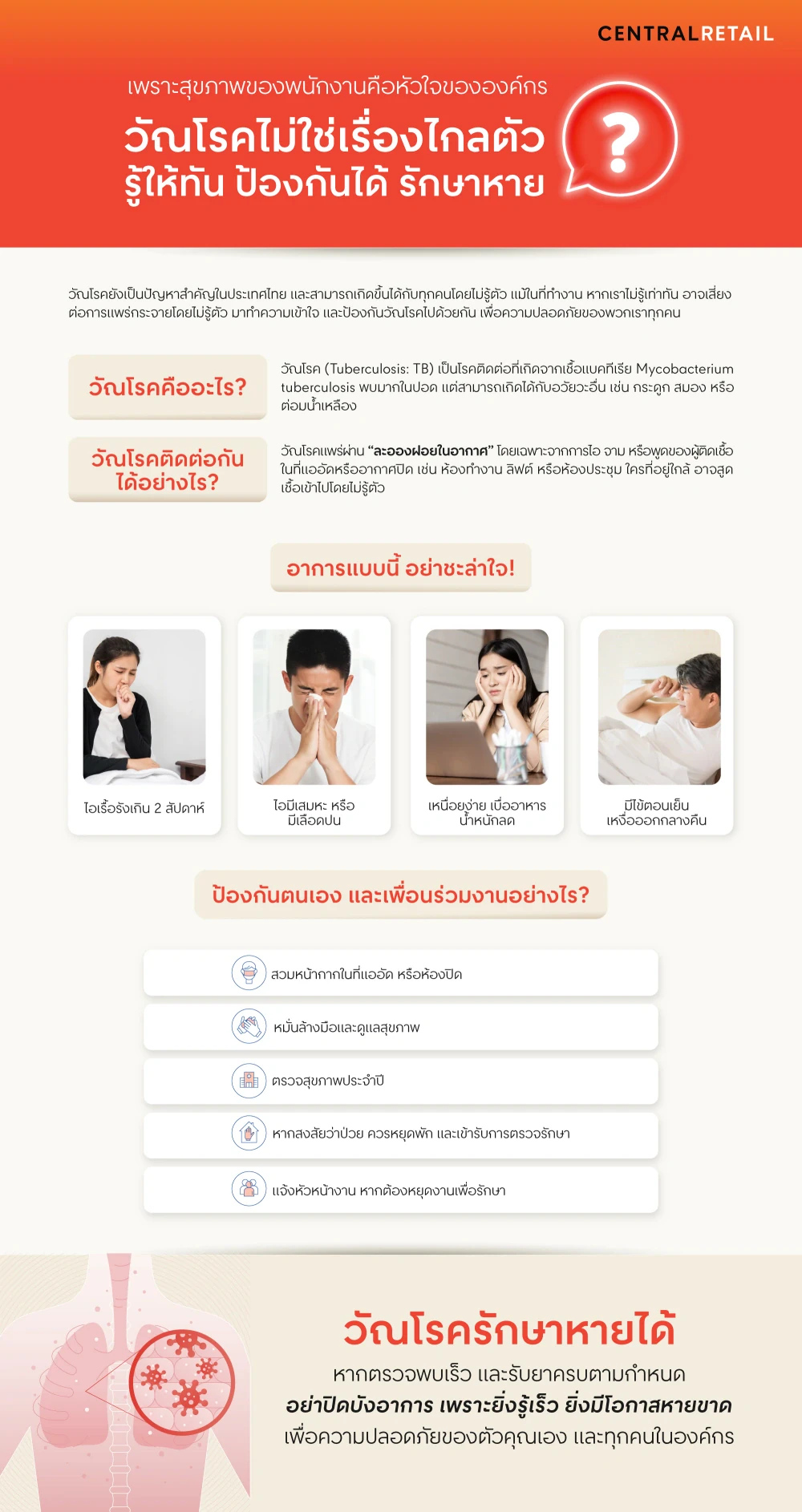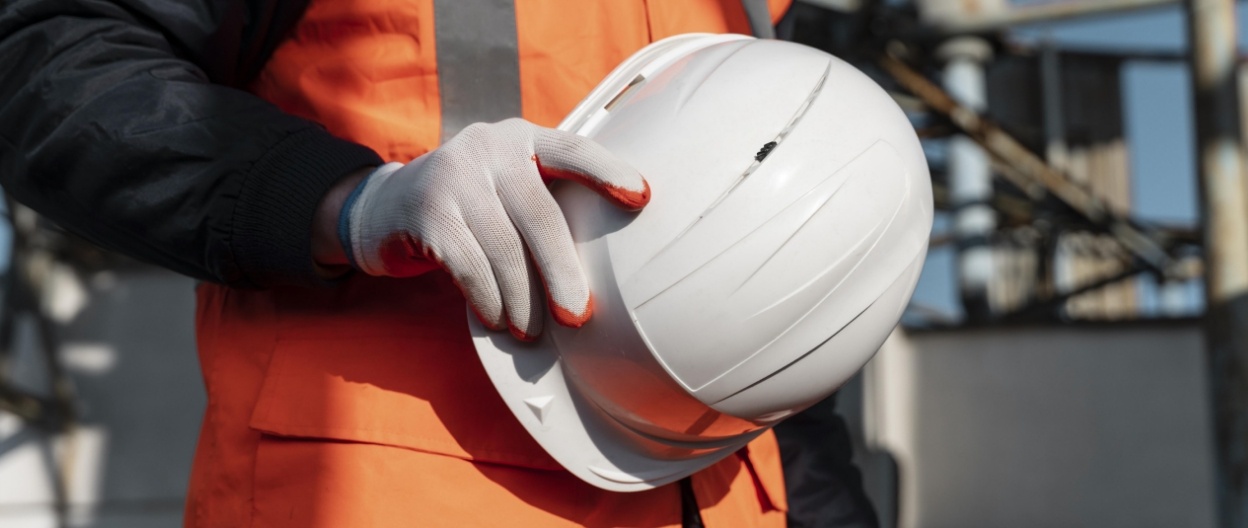Occupational Health and Safety
Challenges and Opportunities
Effective occupational health and safety (OHS) management is essential for fostering a stable and sustainable working environment. Businesses that operate with a large workforce and diverse workspaces must implement comprehensive safety measures. Identifying and mitigating risks related to workplace accidents and hazardous conditions requires continuous attention. Additionally, compliance with varying OHS regulations across different locations is crucial to ensuring the well-being of employees and all stakeholders involved.
A strong commitment to OHS positively impacts organizations in multiple ways. Maintaining a safe work environment enhances employee confidence, reduces the likelihood of accidents and illnesses, and improves overall productivity. At the same time, customers benefit from a safer shopping experience in facilities that adhere to high safety standards. Furthermore, investors and business partners increasingly prioritize organizations with responsible risk management practices, reinforcing trust and strengthening the company’s competitive advantage.
Central Retail prioritizes the continuous development of OHS measures across all operations. Through a proactive approach, the company systematically identifies and mitigates workplace risks, adheres to both national and international safety standards, and fosters a culture of safety through ongoing training and internal communication. Additionally, Central Retail promotes safety best practices across its supply chain, ensuring that business partners align with the Company’s safety standards. These efforts enhance operational efficiency, build stakeholder trust, and contribute to long-term sustainable growth.
Management Approach
Policy Compliance and Performance Oversight
Central Retail has established an Occupational Safety, Health and Work Environment Policy, along with annual quantitative targets. The Company develops action plans to achieve these targets and provides quarterly performance reports to the executive committee or the board of directors. To ensure effective implementation, the Head of Human Resource Department, the Head of Loss Prevention, and the Head of Safety, Occupational Health and Work Environment from each business unit are responsible for overseeing and enhancing the OHS management system. This system covers all employees and contractors across all operational areas, including offices, department stores, rental stores, and distribution centers.
Additionally, Central Retail conducts both internal and external audits annually to ensure compliance with legal requirements and international standards, as outlined below:
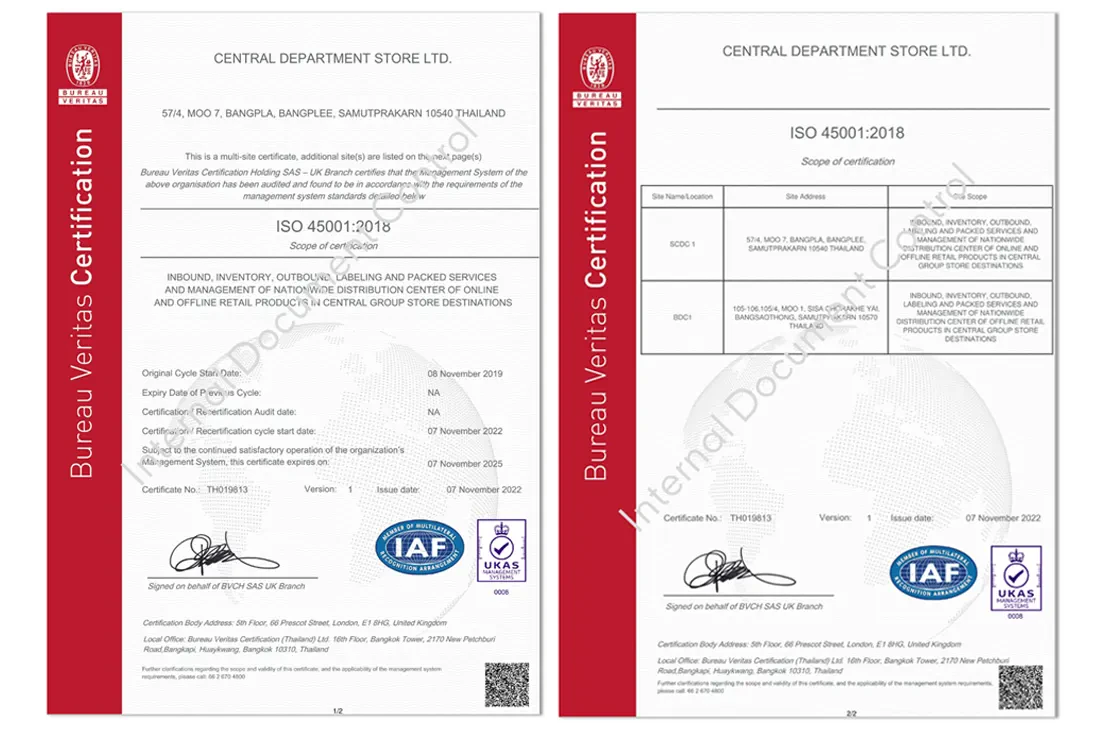
- ISO 45001: 2018 Occupational Health and Safety Management systems
- Machinery Registration Act, B.E. 2514 (1971)
- Machine Registration Act (No. 3), B.E. 2558 (2015)
- Ministerial Regulation, B.E. 2535 (1992) Issued under the Factory Act, B.E. 2535 (1992)
- Building Control Act, B.E. 2535 (1992)
- Labour Protection Act, B.E. 2566 (2023)
- Occupational Safety, Health, and Environment Act, B.E. 2554 (2011)
- Promotion of Labour Skills Development Act (No. 2), B.E. 2557 (2014)
- Ministerial Regulations and Notification of Departments under Various Acts of Thailand
- Occupational Diseases and Environmental Diseases Control Act B.E. 2562 (2019)
- Legislative Decree No. 81 of 2008 on the Consolidated Law on Health and Safety in the Workplace (Italy business unit)
Occupational Safety, Health and Work Environment Policy
Occupational Safety, Health and Work Environment Committee
Occupational Safety, Health and Work Environment Committee of Central Retail consist of branch managers, safety managers, at least two employee representatives, and medical personnel. Their duties include promoting operational compliance and fostering employee participation in implementing various policies and regulations, monitoring results, and continuously improving the efficiency of the occupational safety, health, and work environment management systems. Additionally, the Committee oversees the planning of accident prevention and safety promotion within the relevant branch by organizing Safety Walks. It also keeps an eye on work progress, conducts inspections when work-related illness or injury cases occur, and responds to comments and complaints. The Committee meets monthly and annually to summarize the outcomes of their work, which are obtained through series of consultations and participation of relevant employees. In addition to receiving information on matters relating to work environments and OHS from employee representatives in the committee, each employee has access to online resources and notifications on the Safety Board in each branch and office, which serve as additional sources of policy, guidelines, and news.
Hazard Identification, Risk Assessment and Incident Investigation
Safety officers are responsible for establishing hazard identification and risk assessment processes to serve as guidelines for evaluating potential risks or impacts in the workplace. If employees suffer work-related injuries or illnesses, Central Retail ensures appropriate medical treatment and insurance coverage. Safety officers also conduct accident investigations to determine the root causes.
Findings from hazard identification, risk assessments, and accident investigations are utilized to develop action plans aimed at minimizing risks and preventing recurrence. These plans must include clear indicators and targets to continuously improve the OHS management system. In addition, emergency response measures, ongoing hazard and risk monitoring in the work environment, and regular evaluations are incorporated.
Furthermore, Central Retail has established a process management and database system to ensure comprehensive operational data collection. This approach supports the prioritization of proactive action plans by setting quantitative targets for effectively addressing OHS risks. Progress and performance evaluations are conducted to refine and enhance OHS initiatives, ensuring alignment with the company’s safety objectives.
Central Retail encourages employee and contractor engagement in these processes through regular communication and training initiatives. Processes are in place to prevent any actions deemed risky and report hazards anonymously through supervisors, line managers, and Help Center for assistance and coordination with relevant departments.
Central Retail has established the hierarchy of controls to systematically eliminate the safety hazards after the hazard identification and risk assessment. This approach, allows to mitigate a wide range of hazards, prioritizing the most effective methods including prevention, substitution, engineering and administrative controls, and investment in personal protective equipmentto mitigate workplace risks and hazards for employees and contractors.
Some examples of measures using the hierarchy of controls to mitigate common hazards within Central Retail that may pose risks of work-related injuries and health issues are the following:
| Hazard (Cause of Injury) | Work-related Injury/Ill-Health | Preventive Measure | Substitution Measures | Engineering and Administrative & Control Measures | Personal Protective Equipment |
|---|---|---|---|---|---|
| Slip and fall | Ankle sprain |
|
|
|
Wearing non-slip shoes. |
| Falling off ladders in storage rooms | Broken arm | Automation if applicable. | Switching to a mobile. | Installing guard rails. | Wear head protection. |
| Falling objects in storage rooms | Head injury |
|
|
|
Wear safety shoe. |
| Lifting heavy objects | Injuries on the back and legs | Avoid lifting heavy objects without support. |
|
|
|
| High mental demand of certain tasks | Work-related stress and mental health issues | Prevent long working hours for tasks with high mental demand. | Encourage work-life balance by promoting flexible working arrangements. |
|
|
| Infectious diseases | Getting symptoms of infectious diseases and increase risk of infecting to other employees. |
|
Remote work, or social distancing. |
|
|
| A long period of constant work | Office Syndrome | Organize the working space to Ergonomic design. | Work with appropriate posture and increase movement while working. |
|
|
| Shopping Cart hits people | Hit the feet, legs, or body |
|
|
|
Wearing closed-toe shoes with non-slip soles can help prevent foot injuries. |
Occupational Health and Safety Trainings
Safety officers, meticulously selected from the expertise and experience, lead the implementation and enhancement of OHS management systems. Central Retail requires safety officers and relevant employees to undergo regular training, including enrollment in ISO 45001:2018 Hazard Identification & Risk Assessment courses, annual instruction on relevant laws in each country of operation, and other training that are related every year.
Collaboration among the Human Resource Department, Loss Prevention Department, and each business unit organized online and on-site OHS training for employees. The curriculum includes both mandatory topics as direction of the law, especially in Italy, and voluntary parts. Training topics include hazard identification, risk and danger assessment, work safety manuals, and warehouse case studies. In addition, drivers and delivery personnel will be trained in safe driving or riding techniques. Furthermore, each business unit's Human Resource Department, Loss Prevention Department and Occupational Health and Safety Department are in charge of collecting OHS data to develop the training subjects.
Promoting occupational health and safety in operations
Central Retail is committed to addressing global health challenges by promoting the health and well-being of its employees through targeted initiatives. Central Retail implements programs that tackle both communicable diseases—such as Tuberculosis, Malaria, and HIV/AIDS and non-communicable diseases, as well as mental health concerns. Key initiatives include health education and prevention campaigns focused on raising awareness and reducing the risk of infectious diseases. To further support employee well-being, Central Retail provides regular health screenings, vaccinations, and mental health services as part of its occupational health and safety programs. These efforts reflect the Company’s dedication to fostering a safe, healthy, and supportive work environment.
Apart from that, Central Retail facilitates access to services that are related to OHS, medical and healthcare for employees and contractors. First aid rooms are prepared in each of Central Retail's properties for employees' health welfare reimbursement. Also, Help Center channel is provided for health advice from professional nurses and requests for further assistance.
Alongside the previous initiatives, Central Retail's Italy business unit takes additional steps to prioritize the health and well-being of its employees by offering non-occupational medical and health care services. These voluntary health promotion services and programs are designed to enhance employee's wellness and vitality. It encompasses various initiatives such as 'Safe Zone' mental health talk sessions, discounted fitness memberships, consultations on breast cancer, dermatological check-ups conducted in collaboration with major hospitals, as well as access to private and contracted medical services for employees with supplementary insurance coverage.
Moreover, Central Retail places a strong emphasis on extending OHS measures to encompass suppliers and contractors. Central Retail commits to mitigate risks and ensure a safe working environment for all stakeholders. This commitment is demonstrated through strict compliance with Central Retail's OHS protocols, including the requirement for suppliers and contractors to adhere to appropriate personal protective equipment (PPE) standards. By fostering a culture of safety and collaboration, Central Retail aims to create a sustainable workplace that prioritizes the well-being of everyone involved.
In addition, Central Retail continuously improve its OHS management system by the following approaches:
- Stay up to date with emerging OHS regulations and best practices.
- Encourage employees to suggest new ideas and approaches to improve workplace safety.
- Conduct regular audits and inspections to assess the effectiveness of OHS controls.
- Continuously review and update OHS management approach to reflect changing regulations and industry best practices as needed.
Supplier and Contractor Management
Central Retail has integrated OHS criteria and requirements into its procurement and contracting processes to ensure that suppliers and contractors comply with the company's OHS standards. Contracts signed between the company and its suppliers or contractors explicitly include OHS criteria, along with a thorough review of relevant licenses and certifications. Additionally, in the supplier and contractor selection process, priority is given to those who emphasize and maintain robust OHS management systems. The selection process incorporates various criteria and requirements, such as compliance with OHS regulations, safety training, and the provision of personal protective equipment (PPE). By incorporating OHS criteria into procurement processes, Central Retail effectively mitigates risks, prevents workplace accidents, and fosters a safer working environment across the supply chain.
Project Highlights
First Aid and Emergency Resuscitation (AED)
In 2024, Central Food Retail organized a Basic First Aid and Cardiopulmonary Resuscitation (CPR) with Automated External Defibrillator (AED) training for 1,940 employees from the CFG, PWB, and CDG business units. The training was conducted by expert instructors from the Bangkok Occupational Medicine Center and specialized personnel, providing both theoretical knowledge and hands-on practice in first aid, CPR, and AED usage. The objective of this training was to equip participants with essential knowledge and practical skills to handle emergency situations, particularly sudden cardiac arrest. By enhancing employees’ confidence in providing emergency assistance, this initiative contributes to creating a safer workplace environment and reducing the risk of fatal incidents.
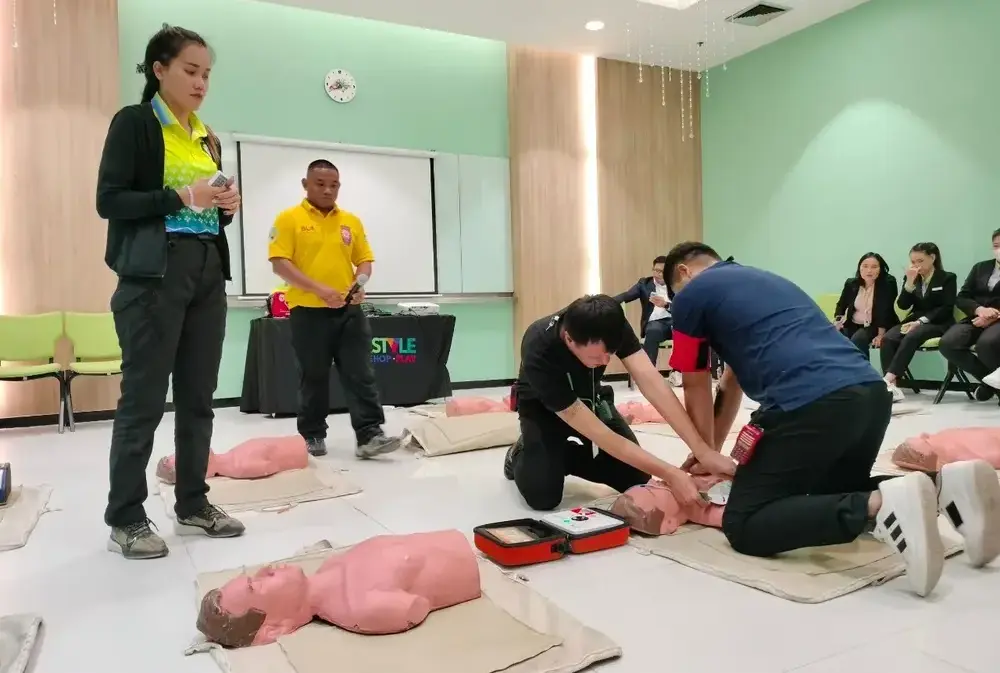
Happiness at Work Training Program
The "Happiness at Work" was held on May 28, 2024, at Central Food Retail's headquarters in Central Chaengwattana. It was jointly organized by Central Food Retail Co., Ltd. and Mental Health Center 4, Department of Mental Health, Ministry of Public Health, with 22 participants attending the training. The program focused on stress management techniques, mental resilience, and fostering happiness in both work and daily life. Participants also practiced mindfulness, letting go of negativity, and adopting a positive perspective, which they can apply in real-life situations. This initiative reflects the organization's commitment to employee mental well-being, contributing to improved work efficiency and long-term organizational sustainability.
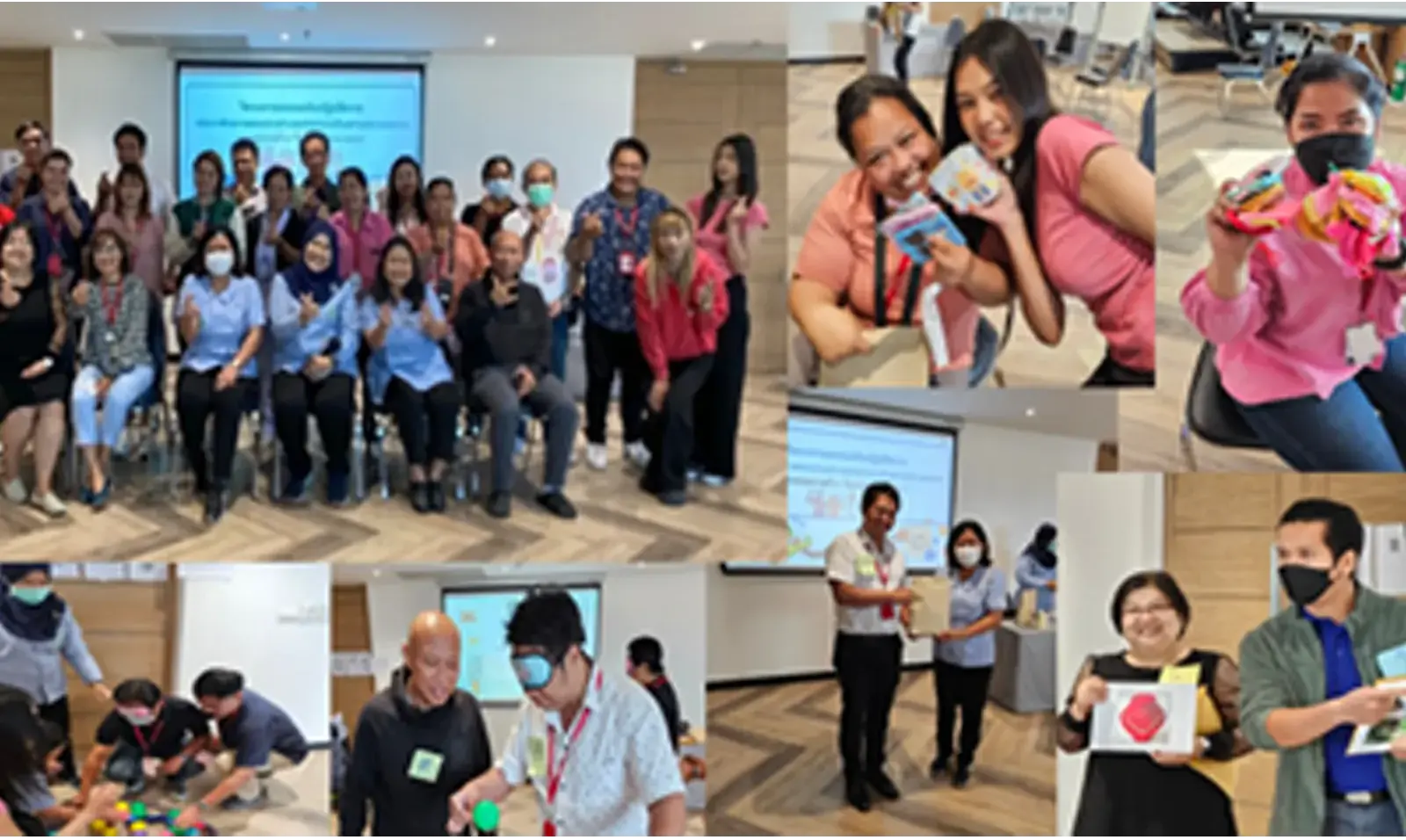
Emergency Drill for 20 Plans
In 2024, Central Retail implemented 20 emergency response plans covering all branches of Central Department Store and Robinson Department Store (all branches) to ensure that executives and employees are well-prepared to handle emergency situations. The primary focus is on protecting the lives of customers, employees, and company assets, as well as ensuring business continuity. These emergency plans cover key incidents such as fire evacuation (practiced annually as required by law), shooter emergency situations (rehearsed annually following CRC executive policy), riots, suspicious objects, gas leaks, customer theft, counterfeit credit cards, suicide attempts, falls from heights, escalator entrapments, elevator malfunctions, earthquakes, floods, customer accidents, lost children, disputes, ceiling collapses, sprinkler malfunctions, and power outages. The program requires store managers, department managers, division managers, and relevant employees to undergo assessment by the Emergency Plan Evaluation Committee with a minimum average score of 80%. These emergency plans enhance confidence among executives, customers, employees, and stakeholders, demonstrating that Central Retail upholds high standards in preventing business disruptions and ensuring safety and security effectively.
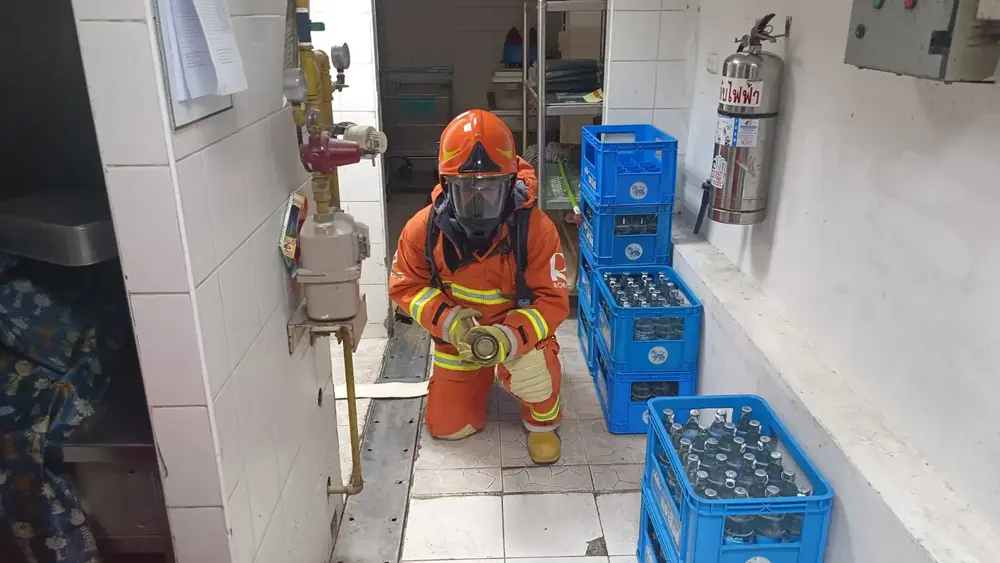
Global Health Awareness
Central Retail places strong emphasis on health communication and awareness campaigns, aiming to raise awareness on key health issues and reduce health risks among employees. One of the Company’s areas of focus is tuberculosis (TB), a public health concern that remains prevalent in many regions. To address this, Central Retail has developed informative materials and internal communication campaigns that cover the nature of the disease, symptoms, modes of transmission, and practical prevention methods.
These efforts are designed to empower employees with accurate and useful health information, enabling them to take care of their own health and help prevent the spread of TB in both the workplace and their personal lives. This initiative aligns with the Company’s broader commitment to promoting employee health and well-being through comprehensive occupational health and safety programs. These programs address communicable and non-communicable diseases as well as mental health, and are aimed at creating a safe, supportive, and healthy working environment for all employees.
